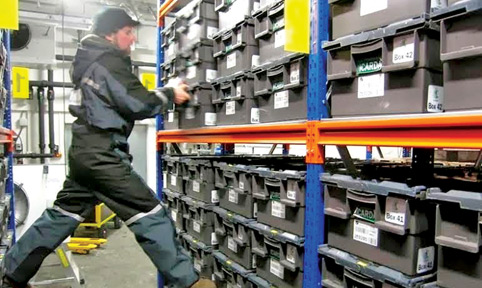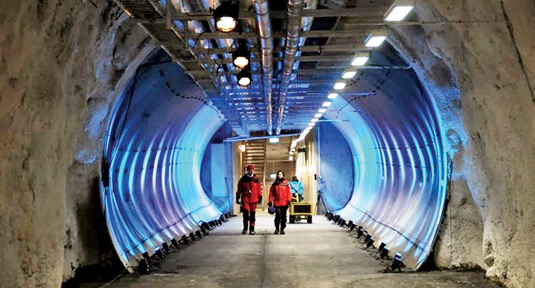|
Svalbard Global Seed Vault:
‘Doomsday Vault’ to preserve seeds
y W.T.J.S.Kaviratne - Ambalangoda special
correspondent
Located in an artificial tunnel carved into an Arctic mountain
covered by permafrost is the ultimate security for global food and
agricultural diversity.
|

The Seed Vault |
‘Svalbard Global Seed Vault' known as “Doomsday Vault” and “Noah's
Arc for World's Seeds” is considered as the ultimate safety net for the
samples of seed collections of important food crops stored in seed banks
or gene banks across the world.
Svalbard Global Seed Vault is constructed at the end of 120 metre
long (131feet) artificial tunnel blasted into a frozen mountain known as
“Pltaberget” made of thick sandstone covered by permafrost.
Svalbard Global Seed Vault is located in close proximity to a very
remote thinly populated town known as Longyearbyen in the Norwegian
Island of Svalbard archipelago belongs to Norway.
Svalbard Global Seed Vault is located only a kilometre away from the
Airport of Longyearbyen which links mainland Norway at least by one
flight a day facilitating the transport of seeds to the Seed Vault.
The distance from the North Pole to Svalbard archipelago is about
1,300 km. and nearly 60 percent of Svalbard landmass is covered by
glaciers.
The total population of the area is estimated to be less than 2,300
people.
It is said that the population of polar bear inhabited in the
Svalbard region is equal to that of its human population.
The temperature of this Arctic region is minus 16 (-16C) degrees
centigrade and Svalbard is in total darkness for three months every year
from November to January.
An internationally renown celebrity in the fields of agriculture,
biodiversity, plant genetics, and crop diversity Cary Fowler was the
mastermind behind this monumental project of Svalbard Global Seed Vault.
The Foundation laying ceremony of the Svalbard Global Seed Vault took
place on June 9th, 2006 with the participation of the Scandinavian Prime
Ministers of Norway, Sweden, Finland, Denmark and Iceland.
On February 25, 2008 depositing the first box of different varieties
of rice samples sent by 104 countries, Svalbard Global Seed Vault(SGSV)
was ceremonially commissioned by the Prime Minister of Norway,
Stoltenberg and the Nobel Prize Winner - Wangari Maathai of Kenya
followed by other dignitaries. Construction of such a global facility
for the conservation of crop diversity found scattered the world over
was considered as yet another giant leap made for the benefit of the
mankind.
A more efficient global system to ensure genetically unique diversity
of food crops and their availability for utilisation had been strongly
felt by the International Treaty on Plant Genetic Resources for Food and
Agriculture (ITPGRFA).
|

Svalbard Seed Vault |
FAO estimates that human beings had used around 10,000 species of
food crops throughout history but now only 120 cultivated crop species
provide around 90 percent of global food requirements.
Dietary energy
Maize, wheat, rice and potatoes provide around 60 percent of dietary
energy of the world's population. The Norwegian Government funded the
construction of the Svalbard Global Seed Vault spending a sum of 45
million Norwegian kroner (9 million USD).
In addition, Norwegian government continues to provide funds to the
amount of 150,000 USD annually for the maintenance of the Seed Vault.
Initial funding from the Global Crop Diversity Trust was made available
from Bill and Melinda Gates Foundation, United Kingdom, Norway,
Australia, Switzerland and Sweden. Brazil, Colombia, Ethiopia and India
had also contributed funds for this global facility. The management,
operation and long term funding of the seed vault are done by the
Norwegian Ministry of Agriculture, the Global Crop Diversity Trust
affiliated to FAO based in Germany and the Nordic Genetic Resources
Centre (NordGen - Sweden).
According to the American Scientist Prof Cary Fowler the former
Executive Director of GCDT “Norway simply couldn't have given the world
a simpler gift than ensuring the genetic diversity of all the World's
Cultivated Plants.”
During the ceremonial opening of this global facility, the Prime
Minister of Royal Norwegian Government, Jens Stoltenberg said “With
climate change and other forces threatening the diversity of life that
sustains our planet, Norway is proud to be playing a central role in
creating a facility capable of protecting what are not seeds but the
fundamental building blocks of human civilisation”.
Svalbard Global Seed Vault is constructed 120 metres (390 feet) deep
inside the frozen sandstone mountain.
The total length of the seed vault from the front door of the portal
building to the back is 145.9 metres (178 feet).
Power
The seed vault is comprised of three chambers for the seed storage
and each chamber is 9.5 to10 metres (31.2 - 32 .8 feet) wide. The length
of each storage chamber is 27 metres (88.6 feet) and 6 metres (19.7
feet) in height.
Power for the refrigeration units which further cool the seeds inside
the vault to the Internationally Approved Standards of -18 degrees
centigrade is provided by locally mined coal in Svalbard archipelago.
The effect of lights on the roof and the entrance of the seed vault
reflecting polar light in the summer months and in the dark Winter give
a muted greenish and white light.
According to Prof Cary Fowler, Svalbard Global seed vault could
withstand a nuclear or missile attack, or a plunging aeroplane.
It is located 130 metres above sea-level if the Greenland and Arctic
Ice Sheets melt due to global warming.
Global Seed Vault was designed to operate by itself. It has
mechanical equipment to lower the natural temperatures from - 4C to - 18
C but all are monitored electronically.
There are over 1,400 gene banks all over the world conserving around
6.5 million samples of all over the world conserving around 6.5 million
samples of genetic resources according to the FAO.
Climate change
In addition to natural disasters of climate change, earthquakes,
rising sea levels and disasters of wars, civil strife, terrorism
together with other issues of poor management, lack of funding and
equipment failure are the major challenges affecting the traditional
gene banks found the world today.
Prof. Cary Fowler says that out of nearly 1,500 existing gene banks
worldwide only 30 to 40 meet the International Standards.Svalbard Global
Seed Vault is not a gene bank but a safety storage facility for the
preservation of duplicate samples of collections of seeds on behalf of
gene banks.
Genetic diversity in seed samples numbering more than 770,000 from
all the continents had already been deposited in Svalbard Global Seed
Vault since its opening.
|

The artificial tunnel |
This facility had been designed to have almost endless lifetime. If
the properly stored and maintained some seeds in the Svalbard Global
Seed Vault be viable for a millennium or more.
Each seed depositing country in the seed vault has to sign a Deposit
Agreement known as “Black Box Agreement” with Norwegian Genetic
Resources Centre(NordGene).
Ownership
The agreement makes clear that Norway does not claim the ownership of
the deposited samples. The ownership remains with the depositor who has
the sole right of access to the samples in the seed vault.
The government of Norway owns the facility and the depositing gene
banks own the seeds they have deposited.
The Coordinator of Operations and Management of the Svalbard Global
Seed Vault, Ola Westengen said Sri Lanka originally deposited seed
samples sent through International Gene Banks in West Africa(WARDA),
Taiwan(TARI), India (ICRISAT), Philippines (IRRI) and US National gene
bank.
The above mentioned gene banks had deposited samples of Sri Lankan
seeds in the Svalbard Global Seed Vault mostly comprised both
domesticated and wild species of rice, samples of millets, cow-pea, mung
beans, ground nuts, and pepper.
The seed portal of Svalbard Global Seed Vault giving information
indicates Sri Lanka had deposited a total amount of 1,728,238 seeds,
Accessions(samples) 2,417, Country Code -LKR. |

